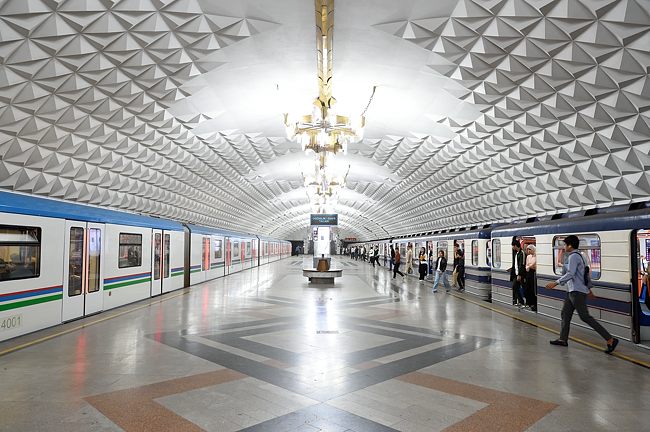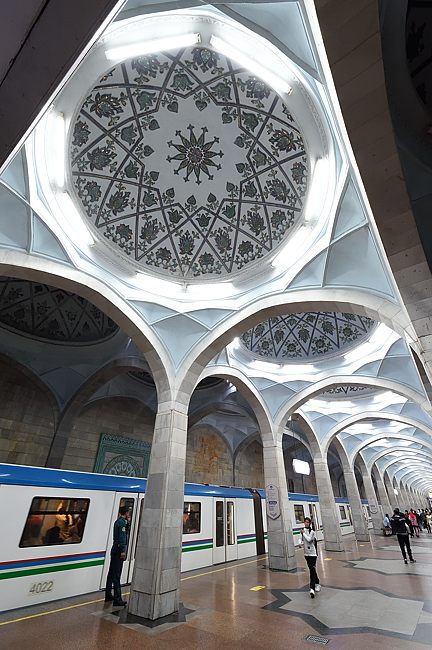You now gaze wonderingly at the Alisher Navoiy metro station in Tashkent, the capital and largest city of Uzbekistan in central Asia. Before it became a republic of its own, Uzbekistan was the Uzbek Soviet Socialist Republic, a satellite state of the defunct and little missed Soviet Union.
Drawbacks aside, status as a Soviet satellite status could offer one important perk, at least for residents of big cities: a spectacular underground. Stalin intended the ornate ‘palaces of the people’ metros of Moscow to showcase the supposed virtues of communism, and spared little expense in their construction. Metros built for Soviet satellites followed a similar pattern. Tashkent’s metro was the seventh built, is regarded as one of the more attractive.
(Although I’ll rank it a notch below the most spectacular stations in Moscow. Mayakovskaya still gets my vote as the planet’s most beautiful metro station.)

I’m not stumping for construction of similar peoples’ palaces in the twenty-first century, unless the host city boasts an unusually generous budget. Madrid held down construction costs largely by not building such palaces. Still: once they’re finished, these strap hanger châteaus are a near holy grail for transit aficionados. And the Soviet style is unique.
I arrived at Tashkent International in the wee hours of October 3, eagerly explored the metro grid later that morning. I plan to write more about Uzbekistan in subsequent posts. This post is about the metro.
GETTING ON BOARD
I prefer to travel with smart cards, a la TAP in Los Angeles, Clipper in San Francisco and the red tarjeta transporte público now in my wallet in Madrid. I can ‘tap’ in quickly at station turnstiles, replenish the card at my convenience and later add the card to my international smart card collection. (I now have thirty-three.)
I thus craved the Tashkent ATTO card. To get it, I whipped up a .pdf (in Russian, widely understood in Uzbekistan) that showed the blue ATTO card and the following text:
Пожалуйста, я хотел бы приобрести эту карту:
Транспортная карта ATTO с 30-дневным пропуском на автобусы и метро
(110 500 сум)
which translates (I hope) to:
Please, I would like to purchase this card:
ATTO transportation card with 30-day pass for buses and metro
(110,500 SOM)
A thirty day pass was ridiculous overkill for a short trip, but 110,500 Uzbekistan SOM comes to a mere eight euros, and I found no other fare rates listed at tashmetro.uz.

The ‘Kassa’ ticket window staffer studied my .pdf, indicated that what I wanted — or her understanding of what I wanted — would cost 250,000 SOM, or €17.89. Fine; good enough. I could ride, never again had to purchase fare media in Tashkent.
Online sources indicate that I could have ‘tapped in’ at the turnstiles with my out-of-country credit card in lieu of an ATTO card. This would have been much cheaper, and would have allowed a visitor to ride the rails without first acquiring Uzbekistan’s SOM coin-of-the-realm at a currency exchange.
NAVIGATION
(♦) Online maps are available in English, Russian and Uzbek. I remembered my trials with the Cyrillic alphabet in Moscow, printed the English map on one side of the sheet and the Russian on the other. The English map served eighty percent of the time, but I occasionally saw only Cyrillic while trying to figure out where I was or where I was going. (Or at least that’s what I remember now, weeks after my return.)
(♦) As in Moscow, I transferred between lines by traversing short tunnels that deposited me in stations with different names. In Madrid, I can board either the 1, 2 or 3 line metros at the Sol station. The ‘Sol’ station name doesn’t change; I have to go to the correct platform for the desired line. In Tashkent, in contrast, I exit the Yunus Rajabi station on the Yunusabad Line and navigate a short tunnel to board the Chilanzar Line at the Amir Temur Avenue station.
RIDING EXPERIENCE
(♦) Assume that no one speaks English or Spanish and you’ll be happily surprised if you stumble into someone who understands a few words. I ran into an English-speaking tour group in Tashkent, but encountered almost no other solo Westerners.

(♦) Stations and metro cars are clean and well-maintained. You won’t see them in these photos, but the system also includes squat blue Soviet-style cars, of the type remembered from visits to Kyiv, Moscow and St. Petersburg.
(♦) Photography in the Tashkent metro has been legal since 2018, and obviously was A-OK with security staff.
(♦) Expect to see lots of security staff, but don’t expect to see any untoward behavior that would call for security. (Uzbekistan rates a ‘Level 1’ safety rating at travel.state.gov, the same as Canada and Japan.) Riders were polite, without exception. Chivalrous Madrileños occasionally now offer me a seat on the metro (which reminds me that I must look much older than I feel), but in Tashkent riders insisted on sacrificing seats to me four times in only two days. A record.
One such experience reminded me of a list I had seen in Qatar of ‘do’s’ and ‘don’ts’ in the Muslim world. A young woman in hijab stood as soon I entered the wagon, but obviously looked uncomfortable when I tried to tell her through gestures that this wasn’t necessary. She shook her head quickly without looking at me, and I sensed that even this much communication with an unknown man had been uncomfortable for her. I took the offered seat and avoided meeting her eyes again.
Uzbekistan is a predominately Sunni Muslim country. I remember lots of hijabs, but also easy-going interaction between women in Muslim attire and bare-headed acquaintances in western garb.

MY BIGGEST TASHKENT MISTAKE
Unquestioning acceptance of negative online reviews of the Tashkent bus grid. It may or may not deserve the lousy press, but the fleet of lime green buses I saw in Tashkent looked clean and well-maintained, and knowledge of the bus network might have allowed me to visit important tourist sites that I wound up skipping.

Spectacular set of pictures, unique perspective, exotic locale. Helps distract me from current events elsewhere, to consider a longer historical view.